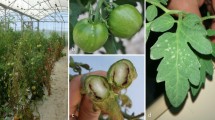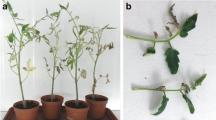Abstract
Bacterial canker of tomato, caused by Clavibacter michiganensis subsp. michiganensis (Cmm), occurs worldwide. This study focuses on three genes, clvA (clavicidin) and two associated genes (clvF and clvG, encoding a putative ABC-type multidrug transport system ATPase and permease component, respectively). Loop-mediated amplification of clvA and PCR of clvA, clvF and clvG showed that these genes were present only in Cmm and not in other Clavibacter species/subspecies, as well as other genera of plant-associated bacteria. Sequences of clvA, clvF and clvG from 48 geographically diverse strains of Cmm were analyzed phylogenetically to determine sequence variation. Maximum parsimony (MP), neighbour-joining (NJ) and maximum likelihood (ML) analyses placed strains into subgroups irrespective of their geographical origins. Multi-locus sequence analysis (MLSA) of these three genes produced the same results. In sum, all three clv genes are unique and conserved in Cmm, further supporting the use of the clvA gene for identification of Cmm, using either a previously designed LAMP assay or PCR with additional primers developed in this study. The genes investigated here are novel targets for specific detection of Cmm and have numerous molecular diagnostic applications.

Similar content being viewed by others
References
Alvarez, A. M., & Kaneshiro, W. S. (1999). Detection and identification of Clavibacter michiganensis subsp. michiganensis in tomato seed. In J. W. Sheppard (Ed.), Proc. 3rd Intl. Seed Testing Association Seed Health Symposium (pp. 93–97). Zurich, Switzerland: Intl. Seed Testing Assn.
Alvarez, A. M., Kaneshiro, W. S., & Vine, B. G. (2005). Diversity of Clavibacter michiganensis subsp. michiganensis populations in tomato seed: what is the significance? Acta Horticulturae, 695, 205–213.
Baysal, Ö., Mercati, F., İkten, H., Yıldız, R. Ç., Carimi, F., Aysan, Y., et al. (2011). Clavibacter michiganensis subsp. michiganensis: tracking strains using genetic differentiations by ISSR markers in Southern Turkey. Physiological and Molecular Plant Pathology, 75, 113–119.
Davis, M. J., Gillespie, A. G. J., Vidaver, A. K., & Harris, R. W. (1984). Clavibacter: a new genus containing some phytopathogenic coryneform bacteria, including Clavibacter xyli subsp. xyli sp. nov, subsp. nov. and Clavibacter xyli subsp. cynodontis subsp. nov., pathogens that cause ratoon stunting disease of sugarcane and bermudagrass stunting disease. International Journal of Systematic Bacteriology, 34, 107–117.
de Queiroz, A., Donoghue, M. J., & Kim, J. (1995). Seperate versus combined analysis of phylogenetic evidence. Annual Review of Ecology and Systematics, 26, 657–681.
Dreier, J., Bermpohl, A., & Eichenlaub, R. (1995). Southern hybridization and PCR for specific detection of phytopathogenic Clavibacter michiganensis subsp. michiganensis. Phytopathology, 85, 462–468.
Eichenlaub, R., & Gartemann, K. H. (2011). The Clavibacter michiganensis subspecies, molecular investigation of gram-positive bacterial plant pathogens. Annual Review of Phytopathology, 49, 7.1–7.20.
Eijsink, V. G. H., Axelsson, L., Diep, D. B., Havarstein, L. S., Holo, H., & Nes, I. F. (2002). Production of class II bacteriocins by lactic acid bacteria; an example of biological warfare and communication. Antonie Van Leeuwenhoek, 81, 639–654.
EPPO. (2005). Clavibacter michiganensis subsp. michiganensis. OEPP/EPPO Bulletin, 35, 275–283.
Farris, J. S., Källersjö, M., Kluge, A. G., & Bult, C. (1994). Testing significance of incongruence. Cladistics, 10, 315–319.
Felsenstein, J. (1985). Confidence limits on phylogenies: an approach using the bootstrap. Evolution, 39, 783–791.
Gartemann, K. H., Kirchner, O., Engemann, J., Gräfen, I., Eichenlaub, R., & Burger, A. (2003). Clavibacter michiganensis subsp. michiganensis: first steps in the understanding of virulence of a Gram-positive phytopathogenic bacterium. Journal of Biotechnology, 106, 179–191.
Guindon, S., Dufayard, J. F., Lefort, V., Anisimova, M., Hordijk, W., & Gascuel, O. (2010). New algorithms and methods to estimate maximum-likelihood phylogenies: assessing the performance of PhyML 3.0. Systematic Biology, 59, 307–321.
Holtsmark, I., Mantzilas, D., Eijsink, V. G. H., & Brurberg, M. B. (2006a). Purification, characterization, and gene sequence of Michiganin A, an actagardine-like lantibiotic produced by the tomato pathogen Clavibacter michiganensis subsp. michiganensis. Applied and Environmental Microbiology, 72, 5814–5821.
Holtsmark, I., Mantzilas, D., Eijsink, V. G. H., & Brurberg, M. B. (2006b). The tomato pathogen Clavibacter michiganensis ssp michiganensis: producer of several antimicrobial substances. Journal of Applied Microbiology, 102, 416–423.
Jacques, M.-A., Durand, K., Ogreur, G., Balidas, S., Fricot, C., Bonneau, S., et al. (2012). Phylogenetic analysis and polyphasic characterization of Clavibacter michiganensis strains isolated from tomato seeds reveal that non-pathgenic strains are distinct from C. michiganensis subsp. michiganensis. Applied and Environmental Microbiology, 78(23), 8388–8402.
Jenkins, D. M., Kubota, R., Dong, J., Li, Y., & Higashiguchi, D. (2011). Handheld device for real-time, quantitative, LAMP-based detection of Salmonella enterica using assimilating probes. Biosensors & Bioelectronics, 30(1), 255–260.
Jukes, T. H., & Cantor, C. R. (1969). Evolution of protein molecules. In H. N. Munro (Ed.), Mammalian protein metabolism (pp. 21–132). New York: Academic.
Kaneshiro, W. S. (2003). Detection and characterization of virulent, hypovirulent, and nonvirulent Clavibacter michiganensis subsp. michiganensis. Honolulu: University of Hawai’i at Mānoa.
Kaneshiro, W. S., Mizumoto, C. Y., & Alvarez, A. M. (2006). Differentiation of Clavibacter michiganensis subsp. michiganensis from seed-borne saprophytes using ELISA, biolog and 16S DNA sequencing. European Journal of Plant Pathology, 16, 45–56.
Kawaguchi, A., Tanina, K., & Inoue, K. (2010). Molecular typing of Clavibacter michiganensis subsp. michiganensis in greenhouses in Japan. Plant Pathology, 59, 76–83.
Kleitman, F., Barash, I., Burger, A., Iraki, N., Falah, Y., Sessa, G., et al. (2008). Characterization of Clavibacter michiganensis subsp. michiganensis population in Israel. European Journal of Plant Pathology, 121, 463–475.
Kubota, R., Vine, B. G., Alvarez, A. M., & Jenkins, D. M. (2008). Detection of Ralstonia solanacaerum by loop-mediated isothermal amplification. Phytopathology, 98(9), 1045–1051.
Lee, I. M., Bartoszyk, I. M., Gunderson-Rindal, D. E., & Davis, R. E. (1997). Phylogeny and classification of bacteria in the genera Clavibacter and Rathayibacter on the basis of 16S rRNA gene sequence analyses. Applied and Environmental Microbiology, 63(7), 2631–2636.
Louws, F. J., Bell, J., Medina-Mora, C. M., Smart, C. D., Opgenorth, D., Ishimaru, C. A., et al. (1998). rep-PCR-mediated genomic fingerprinting: a rapid and effective method to identify Clavibacter michiganensis. Phytopathology, 88, 862–868.
Mickevich, M. F., & Farris, J. S. (1981). The implications of congruence in Menidia. Systematic Zoology, 30, 351–370.
Milijaevšić-Marčić, S., Gartemann, K. H., Frohwitter, J., Eichenlaub, R., Todorović, B., Rekanović, E., et al. (2012). Characterization of Clavibacter michiganensis subsp. michiganensis strains from recent outbreaks of bacterial wilt and canker in Serbia. European Journal of Plant Pathology, 134, 697–711.
Nei, M., & Kumar, S. (2000). Molecular evolution and phylogenetics. New York: Oxford University Press.
Pastrik, K. H., & Rainey, F. A. (1999). Identification and differentiation of Clavibacter michiganensis subspecies by polymerase chain reaction-based techniques. Journal of Phytopathology, 147, 687–693.
Quesada-Ocampo, L. M., Landers, N. A., Lebeis, A. C., Fulbright, D. W., & Hausbeck, M. K. (2012). Genetic structure of Clavibacter michiganensis subsp. michiganensis populations in Michigan commercial tomato fields. Plant Disease, 96(6), 788–796.
Richert, K., Brambilla, E., & Stackebrandt, E. (2005). Development of PCR primers specific for the amplification and direct sequencing of gyrB genes from microbacteria, order Actinomycetales. Journal of Microbiological Methods, 6(1), 115–123.
Rijlaarsdam, A., Woudt, B., Simons, G., Koenraadt, H., Oosterhof, J., Asma, M., et al. (2004). Development of specific primers for the molecular detection of Clavibacter michiganensis subsp. michiganensis. In EPPO Conference on Quality of Diagnosis and New Diagnostic Methods for Plant Pests, Noordwijkerhout, NL.
Riley, M. A., & Gordon, D. M. (1999). The ecological role of bacteriocins in bacterial competition. Trends in Microbiology, 7, 129–133.
Saitou, N., & Nei, M. (1987). The neighbor-joining method: a new method for reconstructing phylogenetic trees. Molecular Biology and Evolution, 4, 406–425.
Sarkar, I. N., Egan, M. G., Coruzzi, G., Lee, E. K., & DeSalle, R. (2008). Automated simultaneous phylogenetics (ASAP): an enabling tool for phylogenetics. BMC Bioinformatics, 9, 103.
Schneider, K. L., Marrero, G., Alvarez, A. A., & Presting, G. G. (2011). Classification of plant associated bacteria using RIF, a computationally derived DNA marker. PLoS, 6(4), e18496.
Sousa Santos, M., Cruz, L., Norskov, P., & Rasmussen, O. F. (1997). A rapid and sensitive detection of Clavibacter michiganensis subsp. michiganensis in tomato seeds by polymerase chain reaction. Seed Science and Technology, 25, 581–584.
Stöver, B. C., & Müller, K. F. (2010). TreeGraph 2: combining and visualizing evidence from different phylogenetic analyses. BMC Bioinformatics, 11, 7. doi:10.1186/1471-2105-11-7.
Strider, D. L. (1969). Bacterial canker of tomato caused by Corynebacterium michiganense: a literature review and bibliography. North Carolina Agric. Exp. Stn., Tech Bull., 193.
Swofford, J. L. (2002). PAUP*. Phylogenetic analysis using parsimony (*and other methods) (4th ed.). Sunderland: Sinauer Associates.
Tamura, K., Peterson, D., Peterson, N., Stecher, G., Nei, M., & Kumar, S. (2011). MEGA5: molecular evolutionary genetics analysis using maximum likelihood, evolutionary distance, and maximum parsimony methods. Molecular Biology and Evolution, 28, 2731–2739.
Vandamme, A.-M. (2003). Basic concepts of molecular evolution. In M. Salemi & A.-M. Vandamme (Eds.), The phylogenetics handbook: A practical approach to DNA and protein phylogeny (pp. 1–23). New York: Cambridge University Press.
Waleron, M., Waleron, K., Kamasa, J., Przewodowski, W., & E., L. (2011). Polymorphism analysis of housekeeping genes for identification and differentiation of Clavibacter michiganensis subspecies. Eur. J. Plant Pathol., 131, 341–354.
Yasuhara-Bell, J., & Alvarez, A. M. (2012). Loop-mediated amplification (LAMP) for specific detection of tomato phytopathogen Clavibacter michiganensis subsp. michiganensis (Cmm). Phytopathology, 102, S4.141.
Yasuhara-Bell, J., & Alvarez, A. M. (2014). Differentiation of Clavibacter michiganensis subsp. michiganensis from other Clavibacter species found in seed and plant tissues. Acta Horticulturae.
Yasuhara-Bell, J., Kubota, R., Jenkins, D. M., & Alvarez, A. M. (2013). Loop-mediated amplification of the Clavibacter michiganensis subsp. michiganensis micA gene is highly specific. Phytopathology, 103(12), 1220–1226.
Yim, K.-O., Lee, H.-I., Kim, J.-H., Lee, S.-D., Cho, J.-H., & Cha, J.-S. (2012). Characterization of phenotypis variants of Clavibacter michiganensis subsp. michiganensis isolated from Capisum annuum. European Journal of Plant Pathology, 133, 559–575.
Zaluga, J., Heylen, K., Van Hoorde, K., Hoste, B., Van Vaerenbergh, J., Maes, M., et al. (2011). GyrB sequence analysis and MALDI-TOF MS as identification tools for plant pathogenic Clavibacter. Systematic and Applied Microbiology, 34, 400–407.
Zaluga, J., Stragier, P., Van Vaerenbergh, J., Maes, M., & De Vos, P. (2013a). Multilocus variable-number-tandem-repeats analysis (MLVA) distinguishes a clonal complex of Clavibacter michiganensis subsp. michiganensis strains isolated from recent outbreaks of bacterial wilt and canker in Belgium. BMC Microbiology, 13(1), 126. doi:10.1186/1471-2180-13-126.
Zaluga, J., Van Vaerenbergh, J., Stragier, P., Maes, M., & De Vos, P. (2013b). Genetic diversity of non-pathogenic Clavibacter strains isolated from tomato seeds. Syst. Appl. Microbiol., 36(6), 426–435, doi:http://dx.doi.org/10.1016/j.syapm.2013.04.005.
Acknowledgments
This work was supported by USDA-NIFA SCRI-600-25320. We thank our colleagues for providing strains from their collections.
Author information
Authors and Affiliations
Corresponding author
Rights and permissions
About this article
Cite this article
Yasuhara-Bell, J., Marrero, G. & Alvarez, A.M. Genes clvA, clvF and clvG are unique to Clavibacter michiganensis subsp. michiganensis and highly conserved. Eur J Plant Pathol 140, 655–664 (2014). https://doi.org/10.1007/s10658-014-0495-5
Accepted:
Published:
Issue Date:
DOI: https://doi.org/10.1007/s10658-014-0495-5




